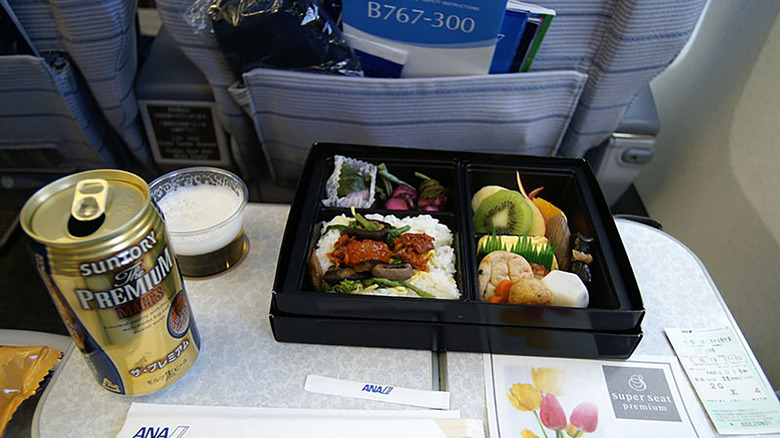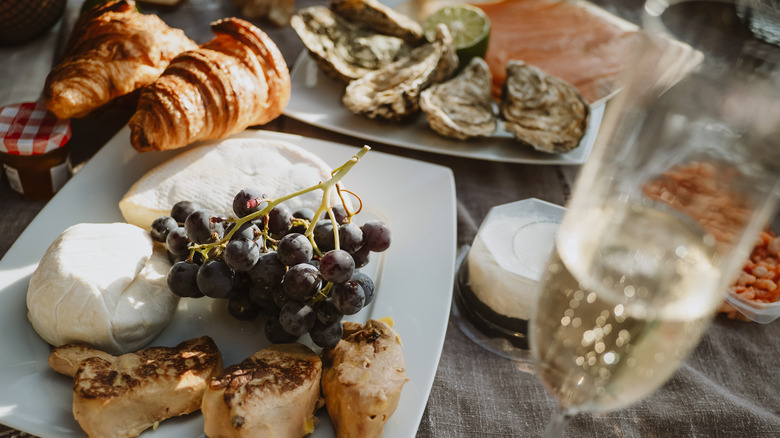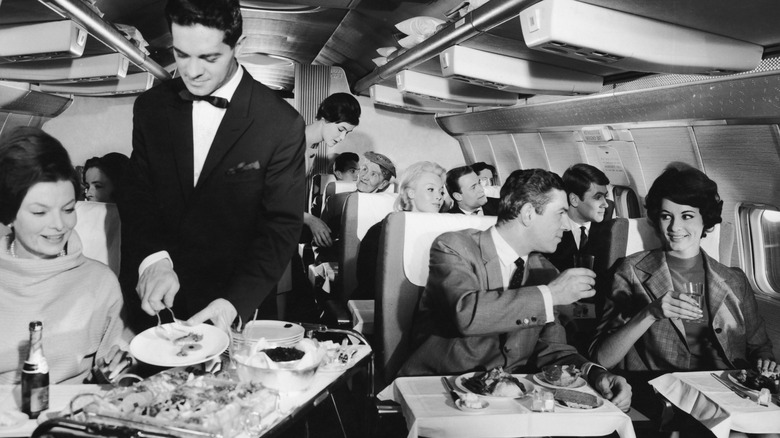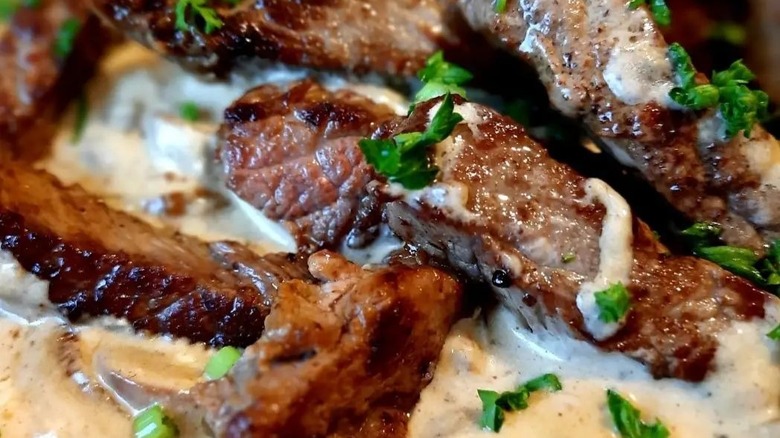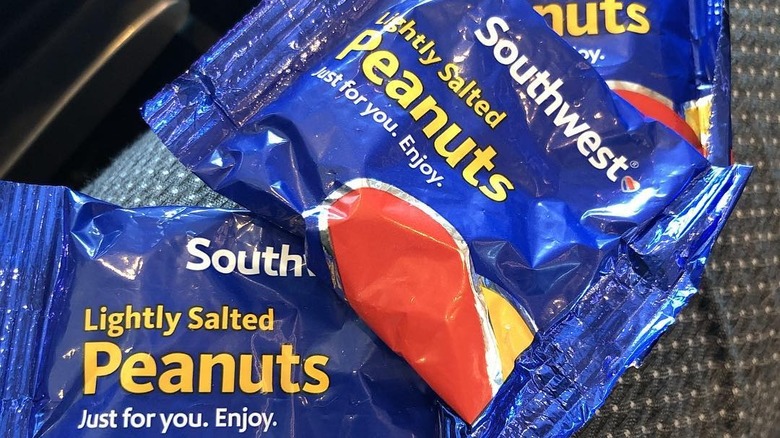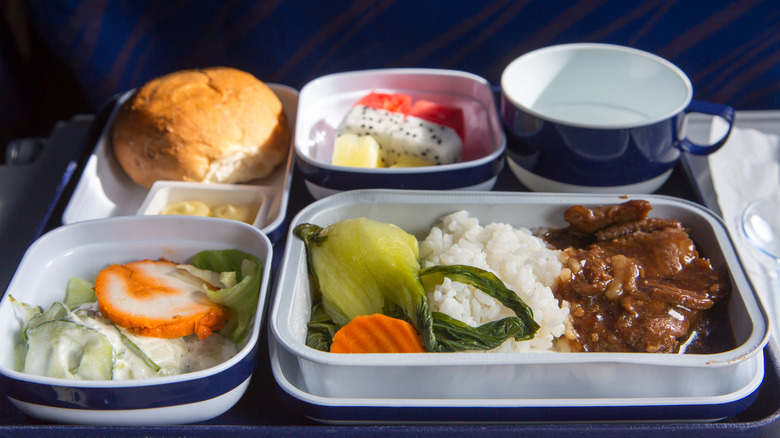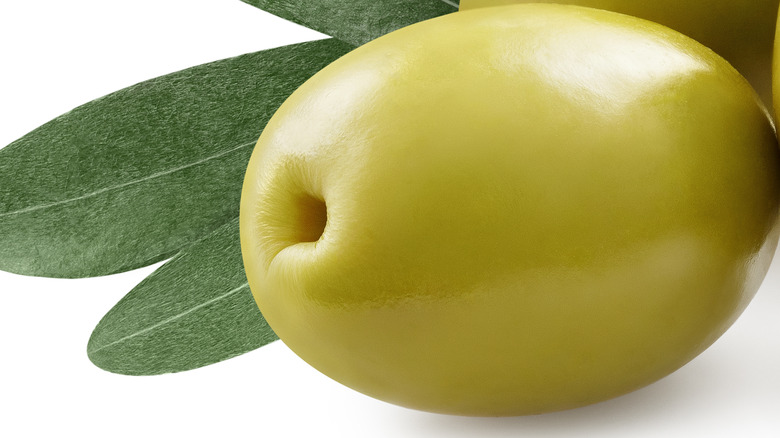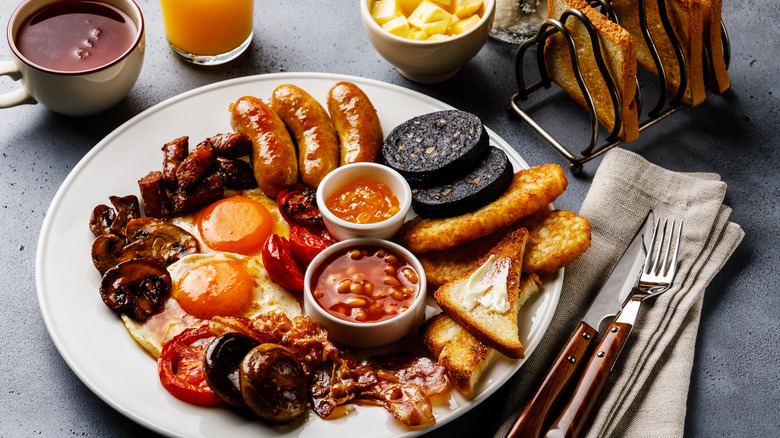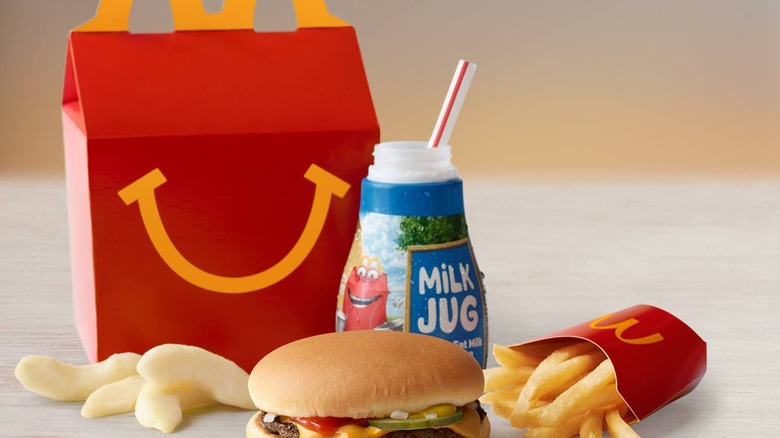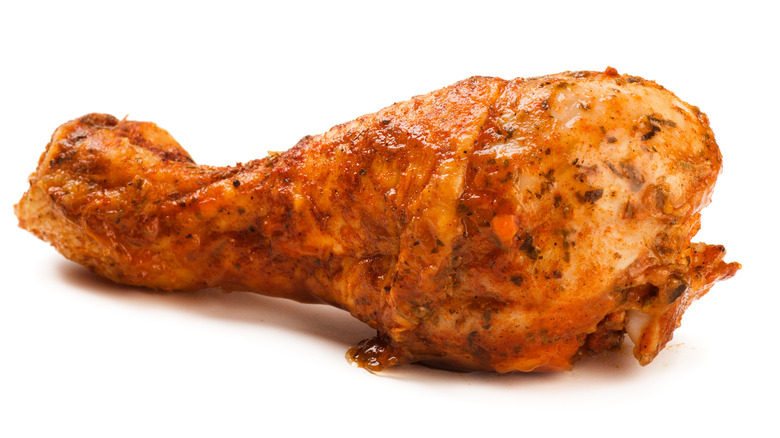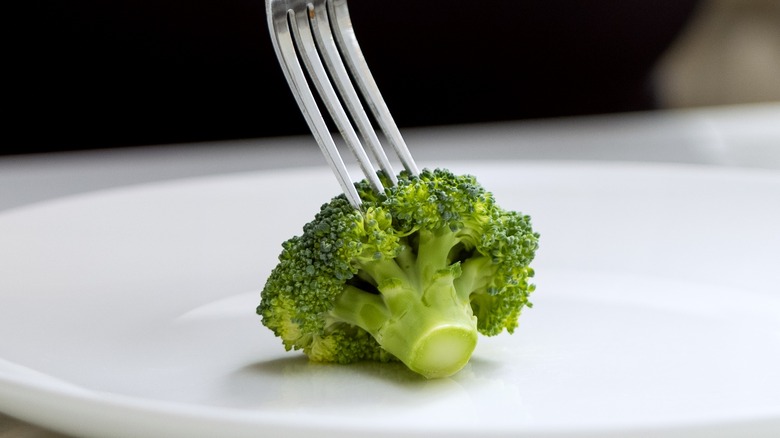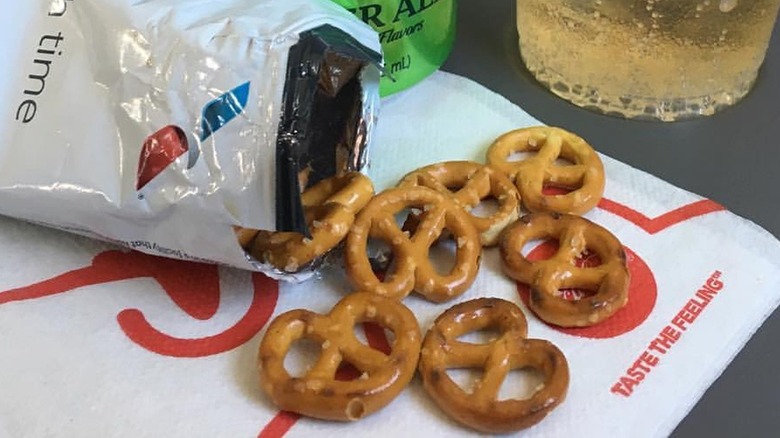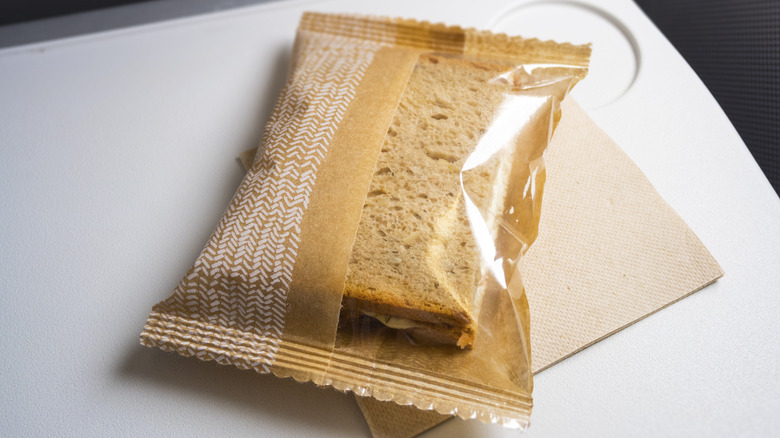What Airplane Food Looked Like The Year You Were Born
According to The Washington Post, airline passengers before 1936 had to pay for a boxed lunch. But in 1936, United Airlines installed a kitchen onboard, and thus began a long history (alternately praised and justifiably mocked) of airline food. As air travel became more popular, more airlines added galleys in which specially trained flight attendants seared steaks and scrambled eggs.
During the 1950s and 1960s, passengers dressed up in their Sunday finest (suit and tie for gents, pearls and gloves for ladies) because air travel was glamorous and exciting. The Daily Mail published a series of photographs depicting multi-course airline meals served on china with silverware and even a vase of flowers. You might look at these extravagant dinners and think, "oh, that was just for first class."
But that was not the case at all. All passengers, no matter where they were seated, were treated to this high-end food, even, sometimes, caviar. An economy passenger could also expect to be served a selection of French wines and cocktails with their appetizer, and if you were so inclined, cigarettes and aperitifs would be provided to aid your digestion.
Sadly, this kind of airplane food was impossible to sustain, and with deregulation in 1978, menus and portions shrunk, and the quality of food for economy passengers deteriorated. Airline food has gone through several different changes over the past five decades.
1963-1966: French cuisine
According to Travel + Leisure, air travel changed dramatically with the introduction of jets in the early 1960s. Airlines became fiercely competitive and began to entice passengers by offering multi-course meals. French food took America by storm, particularly after the publication of Julia Child's "Mastering The Art of French Cooking" in 1961: Almost all major airlines in the 1960s served French cuisine.
In the 1950s, Pan Am Airlines established a partnership with renowned restaurant Maxim's of Paris. Throughout the 1960s and 1970s, Pan Am was the definition of chic airplane travel. First class passengers were offered a varied menu, but economy passengers weren't treated shabbily and also enjoyed an exquisite French meal served with French wines.
Pan Am wasn't alone in giving the French treatment to their passengers. According to CNN Travel, American Airlines would serve beef consommé, chicken in wine sauce, and a fruit tartlet, all announced by a bugler at the beginning of the meal service. Singapore Airlines rolled out a cart overflowing with appetizers, salads, beef Wellington with truffle sauce, and shrimp etouffée. And, of course, complimentary cigarettes were handed out if requested to finish off the huge meal.
1967-1971: Cuisine with a theme
During the mid- to late-60s, themed meals were the rage. Alaskan Airlines embodied full-out luxury with its Golden Samovar service, which treated passengers like they were czars and czarinas of Russia. The airline's press release touted this over-the-top specialty to celebrate "Alaska's colorful Russian heritage," which, according to Alaska.gov, dates back to 1741.
Stewardesses outfitted in stylish black maxi-coats greeted passengers to the strains of the Russian balalaika and served a Seagram-concocted mixed cocktail of coffee, vodka, and liqueurs known as the Bolshoi Golden Troika before take-off. Once in the sky, the caviar trolley was rolled out, and passengers were offered walloping dollops of caviar with the traditional accompaniments of sour cream, chopped egg, blinis, and lemon, along with other Russian delicacies.
One of our favorite themed cuisines was served by TWA (Trans World Airline), the storied and glamorous airline preferred by celebrities and the international jet set. A 1968 TWA menu posted by The Points Guy depicts a fetching stewardess demurely lounging at a pub that would presumably be serving Olde English fare.
The menu featured offerings from "The Serving Wench" and "The Groaning Table." Passengers could dine on deviled lobster, beef brisket with horseradish sauce, broiled lamb chops or dover sole, all washed down with glasses of ale or beer. To top off this Epicurean meal, you could enjoy a jigger of Drambuie, the scotch-and-honey blend created for Bonnie Prince Charlie in the 18th century.
1972-1976: Rich sauces
According to Reader's Digest, United Airlines created the first kitchen devoted to developing airline cuisine that took into account the changes in taste buds and sense of smell at high altitudes. United hired French chef Raymond Oliver in 1973 to improve its passenger meals, and he figured out that anything tasted good at 30,000 feet when it's drenched in butter, cream, or salt.
Former Pan Am stewardess Anne Sweeney recalled that she heated vegetables and meat in the galley, and there was always a rich sauce. As airlines grew more competitive, high-end items would appear on many of their menus. These included dishes such as seafood newberg, boeuf bourguignon, pheasant in sour cream, and lobster a l'Americaine, which, as prepared by Julia Child on "The French Chef," consists of lobster sautéed in a rich, boozy sauce of tomato, lobster coral (eggs), and, naturally, lots of butter.
Beef Strogonoff, indulgently laced with sour cream, was another popular meal from the 1960s that carried over into the 1970s and was served on airlines. Fish often appeared on airline menus, and since it was precooked and frozen, it needed a lot of help to be tasty, and so it was ladled with Bercy sauce, a luscious reduction of fish stock, shallots, and wine, all finished off with butter.
1977: Peanuts
A policy enacted by Southwest Airlines was the beginning of the end of gourmet meals. Southwest lowered air fares by eliminating meals and serving only peanuts in an effort to sell more tickets (via Skift).
Southwest Airlines' marketing experts brilliantly changed what could be perceived as a negative connotation of cheapness into a marketing coup. Southwest, dubbed the "peanut airline," soon became the number-one airline for budget-conscious consumers. Its competitors also cut ticket prices by providing minimal service onboard and serving peanuts.
According to The New York Times, these peanut fares launched a price-fare war as the airlines tried to prove to Congress that fair fares could be offered without deregulating the long-standing rules of the Civil Aeronautics Board.
However, a bill advocated by Senator Edward Kennedy led to deregulation in 1978, which substantially lowered airfares and increased the number of people who could now afford air travel. Consequently, more airlines stayed competitive by cutting out the caviar and passing out baskets of peanuts instead, which stayed on Southwest's "menu" until 2018, when peanut allergies forced the airline to switch to other snacks, according to CNN.
1978-1982: Economy meals
According to Travel + Leisure, the division between first class and "economy" didn't exist until the 1970s. Before then, most airlines offered the same meals to all passengers, and food was served off trolleys onto china plates. To keep up with the demand for air travel, airlines began selling lower-priced tickets, thus creating "economy" (initially called "tourist").
As airlines stocked their fleet with large jets, the number of passengers increased, which meant service needed to speed up so people wouldn't get bored. Eating was the major entertainment for passengers, and getting food served quickly meant switching from glass and plates to plastic.
First-class still got the fancy food and opulent displays, while economy passengers were served a couple of options in the once ubiquitous plastic tray. According to Air Travel Design, the three-course (appetizer, entree, and dessert) meal tray was designed in 1937 and didn't change much over the years.
Scandinavian Airlines recently released a cache of photographs dating from the 1960s to the 1980s, and in one photograph, it's clear that the meals served to economy passengers were similar to those served before 9/11. With deregulation and the necessary cost-cutting, first-class passengers were also served meals in plastic trays, but they still had more menu options than economy passengers.
1983-1987: A single olive
According to The Washington Post, meals served on domestic flights were affected by deregulation. However, if you were lucky enough to score a seat on a transcontinental or international flight, you might enjoy a Christmas dinner. Pan Am's Christmas menu from the 1980s, posted by Everything Pan Am, isn't noteworthy for the turkey or filet mignon on the menu, but when compared to prior Pan Am menus, it's a sad, pale shadow of what Pan Am's meals had been.
Pan Am was obsessed with sustaining its reputation as the most glamorous airline, but the overwhelming cost of doing so led to the airline's demise. According to CNN, Pan Am couldn't keep up with its competitors and shuttered in 1991.
American Airlines took a markedly different approach to deregulation, which had a lasting impact on the industry. According to Forbes, American Airlines was in murky financial waters, and the airline's president Robert Crandell was scouring onboard flight service for ways to cut back. He landed on the idea of removing a single olive from every salad plate, which would save the airline $40,000 annually.
Crandell reasoned that passengers wouldn't miss the single olive, and he was proved right. Nobody complained, which prompted other airlines to excise small food items from their menus. This slow but steady chipping away of food and services improved profits, but it also led to a swift decline in quality.
1988-1990: The Concorde experience
As airline meals were shrinking in size and variety during the late '80s and early '90s, British Airways and Air France's Concorde charged forward with the opposite philosophy that "more is more" (via The History Press). France and Great Britain spent over a decade designing, building, and testing the world's first supersonic commercial jet before its historic inaugural flight in 1976. (Both British Airways and Air France launched passenger service on the same day.)
According to Conde Nast Traveler, a trans-Atlantic ticket price set you back about $12,000, and the hefty airfare gained you entrance to an exclusive club frequented by the likes of Sting, Bruce Springsteen, and flocks of super-models.
The six-person cabin crew served 100 passengers only the best of the best, like Dom Perignon champagne and caviar and meals as lavish as a Michelin-starred restaurant. The full-course meal was dependent on the time the flight departed. In a menu posted by Heritage Concorde, brunch included an appetizer, a traditional British breakfast, plus lamb filet, sea bass, and vegetables.
Naturally, passengers could also partake in the Concorde's extensive wine list and a full bar of top-shelf liquors. The days of this "Dallas"-and-"Dynasty" era were numbered, however, and after a series of catastrophes and technical failures, the Concorde was grounded in 2003.
1991-1993: Friendly Skies meals
According to The Los Angeles Times, airlines ceased selling special airfares for kids sometime in the late 1970s. But after deregulation, airlines were brainstorming on how to attract more passengers. In 1991, United Airlines aimed at getting more families to travel by teaming up with McDonald's to create a version of the Happy Meal.
Advertisements for the Friendly Skies Meal called back to the famous 1965 slogan, "Fly the Friendly Skies." The meal included a cheeseburger, cookies, and a toy, although later, carrot sticks, fruit, and non-fat milk were added. French fries, of course, get soggy when reheated, so they were omitted from the meal. The promotion was initially only offered on a one-way flight to Orlando, Florida, home of Disney World, for $129.
According to an airline-industry consultant, other airlines needed to take a creative approach to get people flying again in a depressed market. United took the lead in welcoming families on board again by designing a special cart that kept the hamburger patties hot and the other items in the Friendly Skies Meal cool.
The promotion was so popular that United added it to other domestic flights and, comically, advertised the cheeseburger as the "chateaubriand for kids." United Airlines discontinued the Friendly Skies Meals in 1993 but announced in late 2022 that kids' meals would be reinstated in certain "eligible cabins."
1994-1998:BBQ chicken leg
Airline food in the 1990s is best remembered as getting less for more money. Long gone are the days when you might be served pheasant in sour cream or a roasted half-chicken. You still might get a little better food in first class or business class, but in economy, you were lucky if you got a size-challenged chicken leg lacquered in overly sweet barbecue sauce, a dinner roll, and a puny portion of the same dessert you'd find in a TV dinner.
Air travel was now mass transportation, and to stay solvent, airlines increased ticket fares and decreased service by justifying that passengers were in a hurry and couldn't care less for a jaunty flight attendant dressed in a beret and maid's outfit or fox-hunting ensemble, or breakfast announced to a recorded soundtrack of bugles and baying hounds, according to The Washington Post and Los Angeles Magazine
Airlines claimed that passengers wanted speed, even if it meant a foil-wrapped aluminum packet tossed at them from a rolling cart. But this was also the time when airlines were diminishing leg room in economy so they could pack in passengers like anchovies, which meant that when you lowered your meal tray, that scrawny BBQ chicken leg was so close to your face that its end bone could poke your eye out.
1999-2001: The 9/11 effect
Whereas first class and business class still got some perks, like free-flowing booze, Michelin-worthy meals, and a gourmet dessert tray, economy passengers were charged for anything they put in their mouths. So rather than suffer through a measly wilted salad and a broccoli floret for five bucks, economy folk brought food onboard, either their own or purchased in the terminal.
According to The Los Angeles Times, airport terminal food was far more enticing than the high-salt, high-fat stuff the airlines served. In 2000, there were 60 restaurants and food concessions in all the terminals at Los Angeles International Airport, where you could also find much healthier options. In 2021, CNBC claimed that more than a fifth of the U.S. population couldn't remember what air travel was like before 9/11. In the aftermath of 9/11, air travel plummeted, and the airline industry hemorrhaged $8 billion in 2001.
Airlines attempted to staunch the financial bleeding by cutting out meals for domestic flights under four hours (under two hours for first class), which it was estimated could save an airline four dollars per meal (via The New York Times). Continental Airlines was the one hold-out and continued to serve meals on all flights. In 2001, Michael Boyd, the president of an airline consulting firm, saw the demise of airline meals beginning before 9/11 and after 9/11, he predicted that airline meals would significantly decline in quality.
2002-2006: Snacks
A reporter for WJBH observed that post 9/11, the nearly destroyed airline industry had to change its image from service-first to security-first. An airline couldn't be budget-conscious about certain essential costs, like equipment and fuel, but food was definitely on the chopping block. The few meals that were served in first class and business class now came with plastic cutlery, and the food served was wrapped and packaged as a security measure.
As usual, economy passengers got the fuzzy end of the lollipop with a small bag of pretzels or peanuts and a soft drink constituting a meal. But as Quartz reports, many airlines were balking at that pathetic meal option since the cost of packaging and loading the snacks onto the aircraft, and even the cost of flight attendants passing them out onboard, wasn't worth it.
For most people traveling economy, airline food totally ceased to exist. Adding insult to injury, the airlines didn't go out of their way to disseminate the pretty-vital information that a meal wouldn't be served, and according to The Washington Post, if you had no time between flight connections to grab a bite, you'd be starving for the second (or third) leg of your flight. It was inevitable that free pretzels would also be eliminated, and airlines would begin charging for snacks instead, as Northwest Airlines (via NBC News). But hey, that six-ounce cup of soda was still free!
2007-2010: Sandwich for a price
The recession of 2008 dramatically impacted the airline industry. According to a report published by the Office of the Inspector General, from 2008 to 2011, fuel prices skyrocketed, air travel decreased, airlines went bankrupt, flights were consolidated, and, naturally, ticket fares increased. This is also the era when passengers were charged for everything that had once been complimentary.
Fees for baggage and seat choice helped the airlines rebound, and the $10 ham-and-cheese sandwich became the new normal. Some airlines charged for snacks and soft drinks, but this obvious display of corporate greed proved unpopular even within competing airlines.
Considering the evolution of airline food over the decades, only economy passengers suffered through this period (the draconian measures of which still exist today), and the champagne continued to flow, and multi-course chef meals were served in first-class and business class.
A few airlines then and now still serve a small meal to economy passengers on international flights, while others offer economy passengers the option of meal (meaning you can choose to starve on a 12-hour flight or not) to purchase a snack box.
